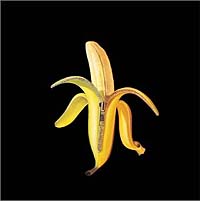 I was intrigued by the new album from the Dandy Warhols because it takes its title from a book by one of my favourite authors, Kurt Vonnegut. I hoped to find some of Vonnegut’s erudite sarcasm and snickering observations on the digressions of religion, society, and humanity at large.
I was intrigued by the new album from the Dandy Warhols because it takes its title from a book by one of my favourite authors, Kurt Vonnegut. I hoped to find some of Vonnegut’s erudite sarcasm and snickering observations on the digressions of religion, society, and humanity at large.
Actually, Welcome to the Monkeyhouse – the album – is nothing like the books of Kurt Jr.
Vonnegut is a literary slap in the face – his prose is at times the philosophical equivalent of hardcore porn: machinations and motivations are laid bare and displayed under floodlamps, accentuating all the lurid details, rendering them a little ridiculous for all this clarity. Vonnegut does not craft absurdity, he reveals it in a way that is simultaneously hilarious and distressing. He is an ice cube down the back of your pants, tin foil on your fillings, and a department store mirror under fluorescent lights. He shows you things you aren’t sure that you want to see.
The Dandy Warhols, on the other hand, will lull you into comfortable ambiguity, but you’ll probably enjoy the trip, unless the sometimes crass digital accoutrements don’t jar you back to reality. There are attempts at profundity, but attempts are all they are. The Warhols are more like slipping into a steaming bath: any brief discomfort is quickly replaced by sleepy contentment. Unfortunately, I think the intent was for the album to be upbeat!
The title track, really just a brief intro to the first single We Used to be Friends, does take a shot at waxing Vonnegutian with the following lines:
Wire is coming back again / Elastica got sued by them
When Michael Jackson dies / We’re covering Blackbird
And won’t it be absurd, then / when no one knows what song they just heard
Just as the only thing Ironic about Alanis Morrisette’s Ironic is that it contains no irony, these lyrics are absurd only because they find absurdity where there is nothing more than a cause for shrugging your shoulders and muttering about the passage of time.
Musically, the entire album has this sort of muted, pastel feel, most noticeable in the layered, hushed vocals which often sound forced and become irritating only two songs in. The vocals only rise above a whisper in “Plan A” and “The Dandy Warhols Love Almost Everyone” where notes of Police-era Sting break through the New Order monotony. Most of the instruments sound soft and harmless, as if all of the sharp edges have been carefully filed down. The synths are the one exception, and by contrast they can be overwhelming. I found myself wishing I could slip some ice down the pants of singer Courtney Taylor-Taylor to get him to break out of whisper-mode for a moment. The vocals on this album make Simon and Garfunkle sound like testosterone junkies.
The band’s namesake, quirky Warhol, purveyor of pop art and the king of kitsch, provides a more apt comparison. The Dandy’s make music that draws from almost every successful pop act of the last 3 decades, homogenized into a familiar but sometimes indistinct funky pop mass. Overall the whole production sounds like it might blow away in a strong wind. It has the somewhat frustrating restraint of a Celtic jig. The legs are moving, but the arms are stiff and immobile. The Warhols want to dance, but they don’t want to mess up their hair.
You would expect that with a production team of Nick Rhodes (Keyboardist for Duran Duran and Arcadia) and Tony Visconti (T. Rex), and Nile Rodgers of Chic lending guitar to one track, that this album might contain some of the slick, snappy, glitter-rock hooks of those era-defining bands.
It’s no surprise that the melody of “You Were the Last High” is very reminiscent of early Duran Duran, but with a hint of Valium. The song is co-written by lead Lemonhead, Evan Dando, which goes a long way toward explaining the rather anaemic overtones.
“We Used to be Friends”, the first single and possibly the best track, is nearly as undeniable as T- Rex’s “Get It On (Bang a Gong)”, but where that song that song insisted that you get up and move, the Warhol’s version sort of slinks in a little half-hearted, and urges you to move a little. It’s also a little misleading for a first single, because it’s the most lively track on the album. The guitars on this track – and indeed all of the album – are mostly obscured under syrupy keyboards and soft vocal harmonies that attempt to recapture the T. Rex magic but mostly don’t work very well. Actually this track prompted me to listen to some old T. Rex, Duran Duran and Chic albums, all of which still sound great.
That said, there are a number of high points on the Welcome to the Monkeyhouse.
“Plan A” begins with the lilting backdrop to a medieval fair, then forays into early Crowded House without the hyper-enthusiasm. The song is enhanced by an infectious bass line and a gilding of bright and funky guitar. “I Am a Scientist” contains lots of “Woo Woo’s” which are delivered cheekily, but with considerably less gusto than in Blur’s definitive “Woo Hoo” track, “Song 2”.
“The Dandy Warhols Love Almost Everyone” has a fun, 60s go-go dancing feel that makes you want to get up and move, but it’s a little unconvincing and slightly laconic, again thanks to the vocals and slightly muffled guitars. It’s a fun and infectious (and very brief) pop rock track, snugly wrapped a cozy blanket. “Insincere Because I”, on the other hand, is dreary and simply annoying, and by the time you get to “I am Sound”, these slow paced, whispered, flower-pop songs start to really irritate. “Heavenly”, though, picks up the pace with a terrific, full-bodied chorus that breaks like sunshine through the melancholy verses.
The Dandy’s have been described as one of the world’s last rock bands. It’s not an accurate appraisal, simply because the band can’t lay claim to rock territory. The Warhols owe much more to Brit pop, dance pop, and the lighter psychedelic pop rock of the 60s. The downplaying of guitar and prominence of synths and electronic beats enhance the overall poppiness of this album, which is distilled from the every great pop song since Billboard started keeping track. From the Beatles to Blur, it’s all in here.
The result is not terribly diverse. In fact every song on the album sounds like it is part of a continuing theme. That’s not entirely a bad thing, but it does get a little old over the fifty minutes that the album spans. It’s a good album with a number of great ideas, but too much of the same throughout, and it all too clearly reveals its unfulfilled potential throughout.


